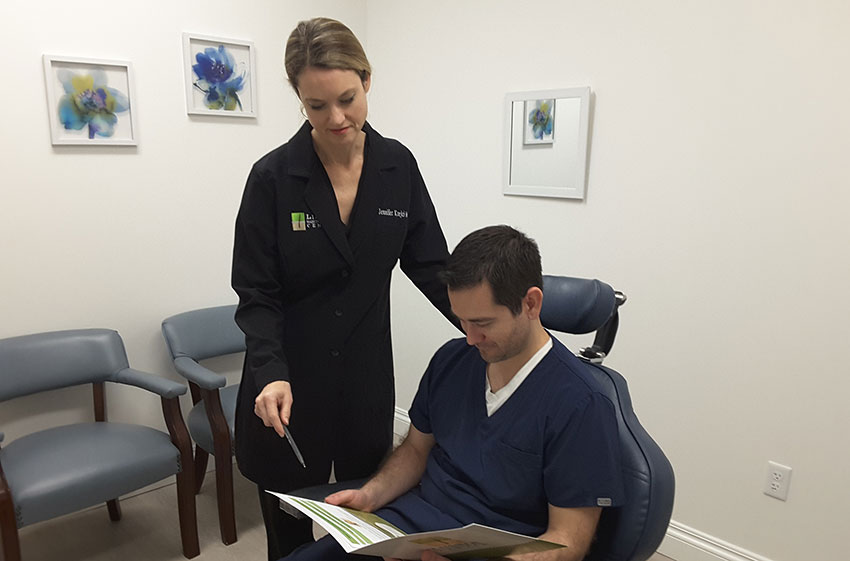
What Is a Hair Transplant / Restoration?
Hair transplantation surgery is a technique that harvests carefully selected hair follicles from a donor section of the body (such as the back of the head) and surgically implants them into the balding site. The result of this minimally invasive procedure is an entirely natural look and feel. Unlike topical and oral medications for hair loss, the results are essentially permanent.
The Advantages of Our Hair Transplant Technique
Although hair transplants have been performed since the late 1800’s, the modern technique of using hair from the genetically stable scalp (the donor area), was developed in the late 1950’s by Dr. Norman Orentreich.
Over the past 30 years, Dr. B.L. Limmer and his research team developed and perfected a technique now referred to nation-wide as the “Gold Standard” of hair transplantation: Microscopically Magnified Follicular Unit Micrografting.
Using Microscopically Magnified Follicular Unit Transplantation, our Doctors produce minute grafts of one to three hair follicles (Follicular Unit) and transplant them into balding areas. When performed by highly skilled individuals such as our Doctors and our technicians, the results are indistinguishable from native hair growth.
Dr. Limmer’s ground-breaking technique is now employed by many of the world’s best hair transplant surgeons.
How Much Does A Hair Transplant Cost?
The cost of a hair transplant will vary from person to person and is contingent upon the number of grafts and the method involved. For the Strip Harvest method, also referred to as FUT, a small case of only 500 grafts, at $10.00 per graft, will vary by case. A larger case, such as to restore an entire frontal hairline with 1,750 grafts, the price per graft is $5.00, will also vary by case.
For the FUE method, small cases of 500 or fewer grafts are $12.00 per graft. Larger cases of more than 1,500 grafts has the cost per graft reduced to $7.00 per graft. It should be noted that performing a hair transplant is a time-consuming, tedious process and requires the strict attention of the attending surgeon. For both FUT and FUE, sessions of over 2,000 grafts will necessitate a 2-day hair transplant session.
Insurance companies will not cover hair transplants as they consider it to be a cosmetic procedure. The good news is that the relative cost of a hair transplant is reasonable for many people to afford.
For a breakdown of pricing, please visit our pricing page.
What Are the Different Types of Transplants?
Currently, we offer two hair transplant options: FUE and FUT. Each comes with pros and cons.
The FUE method, formerly assisted by the ARTAS Robot, is now performed by our surgeons with handheld devices such as the WAW and Trivellini FUE systems. It does not require sutures, which makes post-op pain minimal. Instead of a linear scar it leaves multiple small dot-shaped scars – which are virtually undetectable once healed, even with shorter haircuts. This procedure requires shaving of the entire donor scalp and it costs more than the FUT method.
With the FUT method, dissolvable sutures will be used to close the incision, but they will be covered by the existing hair immediately post-op so it’s less conspicuous. There is no shaving required. You might experience 2-3 days of post-op discomfort, which may require pain medication. A long thin scar is created which can usually be completely covered by ½ inch hair or more. The cost for the FUT method is less than the FUE.
Ask your doctor for advice on which method will be right for the results you’re trying to achieve.
FUE
- Multiple small dot-shaped scars
- No sutures
- Requires shaving of the entire donor area
- Minimal post-op pain
- Scarring is virtually undetectable
- Costs more (Approximately $7-12 per graft)
FUT
- Linear scar
- Dissolvable sutures
- Sutures covered by existing hair post-op
- 2-3 days of post-op discomfort requiring pain medication
- Scar visible with very short hair styles
- Costs less (Approximately $5-10 per graft)
In the end, both methods of extraction provide excellent results for our hair transplant patients. Contact our office in San Antonio, Texas to further discuss which option is best for you.







